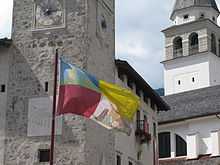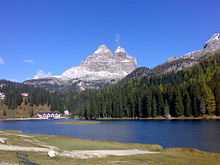Cadore
Cadore is an historical region in the Italian region of Veneto, in the northernmost part of the province of Belluno bordering on Austria, the Trentino-Alto Adige/Südtirol and Friuli-Venezia Giulia. It is watered by the Piave River poured forth from the Carnic Alps. Once a barren and poor district, the former contado (countship) of Cadore now has a thriving economy based on tourism to the Dolomites mountains and small manufacturing industry, specialized in the production of glasses.
History

Originally populated by Euganei and then by the Gauls, the area now known as Cadore was conquered by the Romans during the second century BC, and became part of the Regio X Venetia et Histria.
In Late Antiquity, Cadore was occupied by many invading Germanic populations, was joined to the Duchy of Carinthia and finally, in 1077, to the Patriarchate of Aquileia. From 1135 to 1335, Cadore was ruled by the da Camino family, styled counts of Cadore, who later became Signori of Treviso. Then it was briefly annexed to Tyrol and again to the domains of the Patriarchs of Aquileia. However, the comuni of Cadore always enjoyed a certain degrees of self-government.
When the dogal Republic of Venice conquered the neighbouring Friuli region in 1420 and put an end to the temporal power of the Patriarchs, Cadore, having to choose between Venetian and Imperial allegiance, declared for the former; it became one of many parts of the Terra ferma, admininistered by a local podestà.
The conflict between Venice and the Empire broke out again at the beginning of the 16th century, during the War of the League of Cambrai; the Venetians and Cadorines defeated Maximilian I, Holy Roman Emperor in 1508 at the Battle of Valle di Cadore, and again in 1509. Then, in 1511, Maximilian conquered the town of Cortina d'Ampezzo, which was once and for all assigned to the Empire in 1516. Cortina, formerly considered part of Cadore, has ever since developed a distinct identity.
Cadore remained part of the Venetian Republic until the Napoleonic War. A famous Venetian incumbent of the local post of Commisario del Cadore ('Commissioner'; in 1589) was Paolo Paruta. Napoleon I Bonaparte created it a duché grand-fief, a rare, hereditary but nominal honor of ducal rank (extinguished in 1893), for his minister and admiral Jean-Baptiste Nompère de Champagny.
Being a part of the Kingdom of Lombardy-Venetia, Cadore was ruled by Austria until 1866, when it was conquered by the newly formed Kingdom of Italy with the Third War of Independence. During the First World War, Cadore was on the Alpine Front and was the scene of many battles.
The celebrated Renaissance painter Titian was born in Cadore in 1477, one of a family of four born to Gregorio Vecelli, a distinguished councillor and soldier descended from the counts, and his wife Lucia. The painter's birthplace in Pieve di Cadore, in a locality named Arsenale between the castle and the village Sotto Castello, is open to visitors. Titian's wife, Cecilia, was also born in Cadore, the daughter of a barber.
Comuni of Cadore
Cadore is generally subdivided into Comelico, Sappada, Central Cadore and Boite Valley. The Cadore mountain community includes 22 comuni:

- Auronzo di Cadore
- Borca di Cadore
- Calalzo di Cadore
- Cibiana di Cadore
- Comelico Superiore
- Danta di Cadore
- Domegge di Cadore
- Lorenzago di Cadore
- Lozzo di Cadore
- Ospitale di Cadore
- Perarolo di Cadore
- Pieve di Cadore
- San Nicolò di Comelico
- San Pietro di Cadore
- Santo Stefano di Cadore
- San Vito di Cadore
- Sappada
- Selva di Cadore
- Valle di Cadore
- Vigo di Cadore
- Vodo di Cadore
- Zoppè di Cadore
See also
Sources and references
 This article incorporates text from a publication now in the public domain: Chisholm, Hugh, ed. (1911). Encyclopædia Britannica (11th ed.). Cambridge University Press.
This article incorporates text from a publication now in the public domain: Chisholm, Hugh, ed. (1911). Encyclopædia Britannica (11th ed.). Cambridge University Press. This article incorporates text from a publication now in the public domain: Herbermann, Charles, ed. (1913). Catholic Encyclopedia. Robert Appleton Company. (passim)
This article incorporates text from a publication now in the public domain: Herbermann, Charles, ed. (1913). Catholic Encyclopedia. Robert Appleton Company. (passim)- Storia del Cadore (Italian)
- Heraldica.org Napoleonic heraldry
External links
- Cadore web portal(Italian)
- Old postcards from Tai di Cadore(Italian)
Coordinates: 46°23′47″N 12°21′25″E / 46.39639°N 12.35694°E